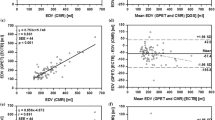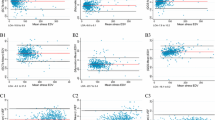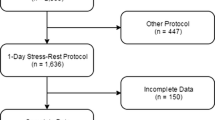Abstract
Background
Increased left ventricular mass (LVM) has been correlated with adverse cardiac events, such as sudden cardiac death. However, LVM quantitation with widely utilized gated SPECT myocardial perfusion imaging (MPI) software, has little validation and clinical application. Thus, we compared LVM from two commonly employed gated SPECT packages [4D-MSPECT® (4DM) and Quantitative Perfusion SPECT® (QPS)] with the 3-dimensional reference standard, CT angiography (CTA).
Methods
Comparisons were made in 56 patients (mean age 61.4 ± 14.6; 32% female) referred for dual-isotope or low-dose/high-dose Tc-99m-tetrofosmin rest/stress MPI and cardiac CTA (mean 1.5 ±4.5 months apart). LVM measurement was performed for both CTA and MPI by two independent observers blinded to clinical information.
Results
Correlation with CTA was best for post-stress MPI than at rest; thus, post-stress values are reported. Values obtained with each of the techniques were very highly reproducible (interobserver correlation r = 0.99 for each technique). The mean LVM values were 142 g by CTA, 145 g by 4DM, and 135 g by QPS (P = NS for CTA vs SPECT, but P < .001 for 4DM vs QPS). There was moderately good correlation between CTA and SPECT LVM data (r = 0.74 and 0.72 for 4DM and QPS, respectively; both P < .001). However, on Bland-Altman analysis there was significant overestimation of lower values and underestimation of higher CT LVM values by both QPS and 4DM (both r = 0.68 and 0.69, P < .001). The limits of agreement relative to CT LVM were wide (−52.1 g to 64.1 g for QPS; and −60.0 g to 53.5 g for 4DM).
Conclusions
SPECT and CTA give reproducible measures of LVM. Using CTA as the reference standard, the mean SPECT LVM values are similar, but lower values are overestimated and higher values are underestimated. Thus, the SPECT values are not substitutable for CTA without mathematical correction.




Similar content being viewed by others
References
Haider AW, Larson MG, Benjamin EJ, Levy D. Increased left ventricular mass and hypertrophy are associated with increased risk for sudden death. J Am Coll Cardiol 1998;32:1454-9.
Kannel WB, Levy D, Cupples LA. Left ventricular hypertrophy and risk of cardiac failure: Insights from the Framingham Study. J Cardiovasc Pharmacol 1987;10:S135-40.
Kannel WB, Abbott RD. A prognostic comparison of asymptomatic left ventricular hypertrophy and unrecognized myocardial infarction: The Framingham Study. Am Heart J 1986;111:391-7.
Bluemke DA, Kronmal RA, Lima JA, et al. The relationship of left ventricular mass and geometry to incident cardiovascular events: The MESA (Multi-Ethnic Study of Atherosclerosis) study. J Am Coll Cardiol 2008;52:2148-55.
Levy D, Garrison RJ, Savage DD, Kannel WB, Castelli WP. Prognostic implications of echocardiographically determined left ventricular mass in the Framingham Heart Study. N Engl J Med 1990;322:1561-6.
Maruyama K, Hasegawa S, Nakatani D, et al. Left ventricular mass index measured by quantitative gated myocardial SPECT with 99mTc-tetrofosmin: A comparison with echocardiography. Ann Nucl Med 2003;17:31-9.
Faber TL, Cooke CD, Folks RD, et al. Left ventricular function and perfusion from gated SPECT perfusion images: An integrated method. J Nucl Med 1999;40:650-9.
Yamaoka O, Yabe T, Okada M, et al. Evaluation of left ventricular mass: Comparison of ultrafast computed tomography, magnetic resonance imaging, and contrast left ventriculography. Am Heart J 1993;126:1372-9.
Schlosser T, Mohrs OK, Magedanz A, Voigtlander T, Schmermund A, Barkhausen J. Assessment of left ventricular function and mass in patients undergoing computed tomography (CT) coronary angiography using 64-detector-row CT: Comparison to magnetic resonance imaging. Acta Radiol 2007;48:30-5.
Diethelm L, Simonson JS, Dery R, Gould RG, Schiller NB, Lipton MJ. Determination of left ventricular mass with ultrafast CT and two-dimensional echocardiography. Radiology 1989;171:213-7.
Germano G, Kavanagh PB, Chen J, et al. Operator-less processing of myocardial perfusion SPECT studies. J Nucl Med 1995;36:2127-32.
Nakajima K, Higuchi T, Taki J, Kawano M, Tonami N. Accuracy of ventricular volume and ejection fraction measured by gated myocardial SPECT: Comparison of 4 software programs. J Nucl Med 2001;42:1571-8.
Schaefer WM, Lipke CS, Nowak B, et al. Validation of QGS and 4D-MSPECT for quantification of left ventricular volumes and ejection fraction from gated 18F-FDG PET: Comparison with cardiac MRI. J Nucl Med 2004;45:74-9.
Raman SV, Shah M, McCarthy B, Garcia A, Ferketich AK. Multi-detector row cardiac computed tomography accurately quantifies right and left ventricular size and function compared with cardiac magnetic resonance. Am Heart J 2006;151:736-44.
Bland JM, Altman DG. Statistical methods for assessing agreement between two methods of clinical measurement. Lancet 1986;1:307-10.
Myerson SG, Bellenger NG, Pennell DJ. Assessment of left ventricular mass by cardiovascular magnetic resonance. Hypertension 2002;39:750-5.
Myerson SG, Montgomery HE, World MJ, Pennell DJ. Left ventricular mass: Reliability of M-mode and 2-dimensional echocardiographic formulas. [see comment]. Hypertension 2002;40:673-8.
Bastarrika G, Arraiza M, De Cecco CN, Mastrobuoni S, Ubilla M, Rabago G. Quantification of left ventricular function and mass in heart transplant recipients using dual-source CT and MRI: Initial clinical experience. Eur Radiol 2008;18:1784-90.
Yamamuro M, Tadamura E, Kubo S, et al. Cardiac functional analysis with multi-detector row CT and segmental reconstruction algorithm: Comparison with echocardiography, SPECT, and MR imaging. Radiology 2005;234:381-90.
Persson E, Carlsson M, Palmer J, Pahlm O, Arheden H. Evaluation of left ventricular volumes and ejection fraction by automated gated myocardial SPECT versus cardiovascular magnetic resonance. Clin Physiol Funct Imaging 2005;25:135-41.
Soneson H, Ubachs JF, Ugander M, Arheden H, Heiberg E. An improved method for automatic segmentation of the left ventricle in myocardial perfusion SPECT. J Nucl Med 2009;50:205-13.
Akinboboye O, Germano G, Idris O, et al. Left ventricular mass measured by myocardial perfusion gated SPECT. Relation to three-dimensional echocardiography. Clin Nucl Med 2003;28:392-7.
Lang RM, Bierig M, Devereux RB, et al. Recommendations for chamber quantification: A report from the American Society of Echocardiography’s Guidelines and Standards Committee and the Chamber Quantification Writing Group, developed in conjunction with the European Association of Echocardiography, a branch of the European Society of Cardiology. J Am Soc Echocardiogr 2005;18:1440-63.
DePuey EG, Nichols K, Dobrinsky C. Left ventricular ejection fraction assessed from gated technetium-99m-sestamibi SPECT. J Nucl Med 1993;34:1871-6.
Faber TL, Cooke CD, Peifer JW, et al. Three-dimensional displays of left ventricular epicardial surface from standard cardiac SPECT perfusion quantification techniques. J Nucl Med 1995;36:697-703.
Everaert H, Bossuyt A, Franken PR. Left ventricular ejection fraction and volumes from gated single photon emission tomographic myocardial perfusion images: Comparison between two algorithms working in three-dimensional space. J Nucl Cardiol 1997;4:472-6.
Schepis T, Gaemperli O, Koepfli P, et al. Comparison of 64-slice CT with gated SPECT for evaluation of left ventricular function. J Nucl Med 2006;47:1288-94.
Author information
Authors and Affiliations
Corresponding author
Rights and permissions
About this article
Cite this article
Okwuosa, T.M., Hampole, C.V., Ali, J. et al. Left ventricular mass from gated SPECT myocardial perfusion imaging: Comparison with cardiac computed tomography. J. Nucl. Cardiol. 16, 775–783 (2009). https://doi.org/10.1007/s12350-009-9131-8
Received:
Revised:
Accepted:
Published:
Issue Date:
DOI: https://doi.org/10.1007/s12350-009-9131-8




